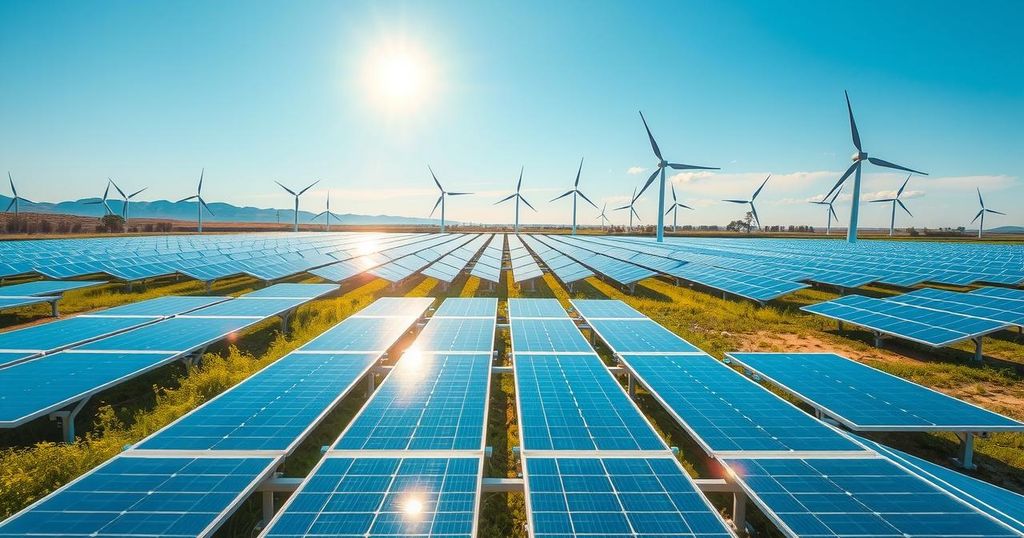China’s Green Energy Strategy: A Blueprint for Bangladesh’s Sustainable Future
China’s significant advancements in green energy, particularly in renewable sources like solar and wind, position it as a global leader in the sector, crucial for achieving carbon neutrality by 2060. By sharing successful strategies, such as investment incentives and innovative technologies from companies like Sichuan Shudao, Bangladesh can improve air quality and transition towards sustainable energy solutions, addressing its reliance on fossil fuels while leveraging abundant natural resources.
China has established itself as a global leader in the green energy sector by significantly investing in renewable energy sources to achieve carbon neutrality by 2060. This investment has focused on technologies such as solar, wind, and hydropower, with China attaining the highest capacities for solar, wind energy, and electric vehicles globally by 2024. Moreover, China plays a crucial role in manufacturing solar panels, wind turbines, and energy storage systems, thereby influencing global environmental policies and technologies.
One of the key strategies driving China’s success in green energy has been substantial investment in renewable infrastructure. Initiatives such as tax incentives and low-interest loans for solar and wind companies have spurred innovation and growth in the sector. Additionally, China has built a comprehensive electric vehicle network to address transportation emissions, a significant source of pollution within the country.
Sichuan Shudao Equipment and Technology Co. has been a notable contributor to this green transition by advancing technologies related to wind and solar energy. This company specializes in developing high-efficiency wind turbines and solar panels, enhancing energy generation efficiency and affordability. Their onshore and offshore wind turbine designs not only increase output but provide valuable insights for Bangladesh’s energy diversification efforts.
The advancements made by Sichuan Shudao in solar technology, utilizing cutting-edge materials and techniques, contribute to large-scale solar projects that significantly generate energy. Their focus on energy storage solutions is pivotal for ensuring that renewable energy remains accessible even during periods of low sunlight, thus promoting a stable energy supply.
For Bangladesh, which receives ample sunlight but struggles with energy accessibility, implementing similar solar strategies could be pivotal in meeting clean energy demands. Given the country’s severe air quality issues, primarily in Dhaka, China’s green energy methods present a viable pathway to addressing these challenges, as Bangladesh has consistently faced poor air quality linked to pollution and health risks.
Bangladesh’s heavy reliance on coal and fossil fuels contributes to a substantial carbon footprint, making the transition to renewable energy essential for pollution reduction. Adopting China’s green energy strategies could help Bangladesh in lessening its fossil fuel dependency. Utilizing its abundant sunlight and wind resources, Bangladesh has the potential to develop its renewable energy capabilities.
Furthermore, replicating China’s model of incentivizing renewable energy infrastructure development can spur both public and private sector investments in Bangladesh. By offering tax incentives for renewable energy projects, the country can encourage wider adoption of clean energy solutions. Fostering energy storage systems will ensure the viability of renewable energy during periods of low production, thus improving air quality by reducing the reliance on coal-fired power plants and promoting electric vehicle usage.
Additionally, Bangladesh may glean insights from China’s green manufacturing targets, which focus on retrofitting industries with energy-efficient technologies to mitigate emissions. In conclusion, by emulating China’s leadership in green energy, Bangladesh can significantly improve air quality while establishing a sustainable energy future. Through robust policies, targeted investments, and incentives for renewable technologies, Bangladesh has the opportunity to not only tackle local air quality issues but also contribute positively to global climate initiatives.
In conclusion, China’s effective green energy strategy offers essential insights for Bangladesh as it seeks to tackle pressing environmental challenges. By investing in renewable energy and related technologies, Bangladesh can reduce its carbon footprint and improve public health outcomes. Furthermore, adopting supportive policies and incentives will pave the way for a more sustainable energy future. This alignment with global climate efforts can help Bangladesh transition to a cleaner, healthier environment, fostering both national and global benefits.
Original Source: www.thedailystar.net








Post Comment